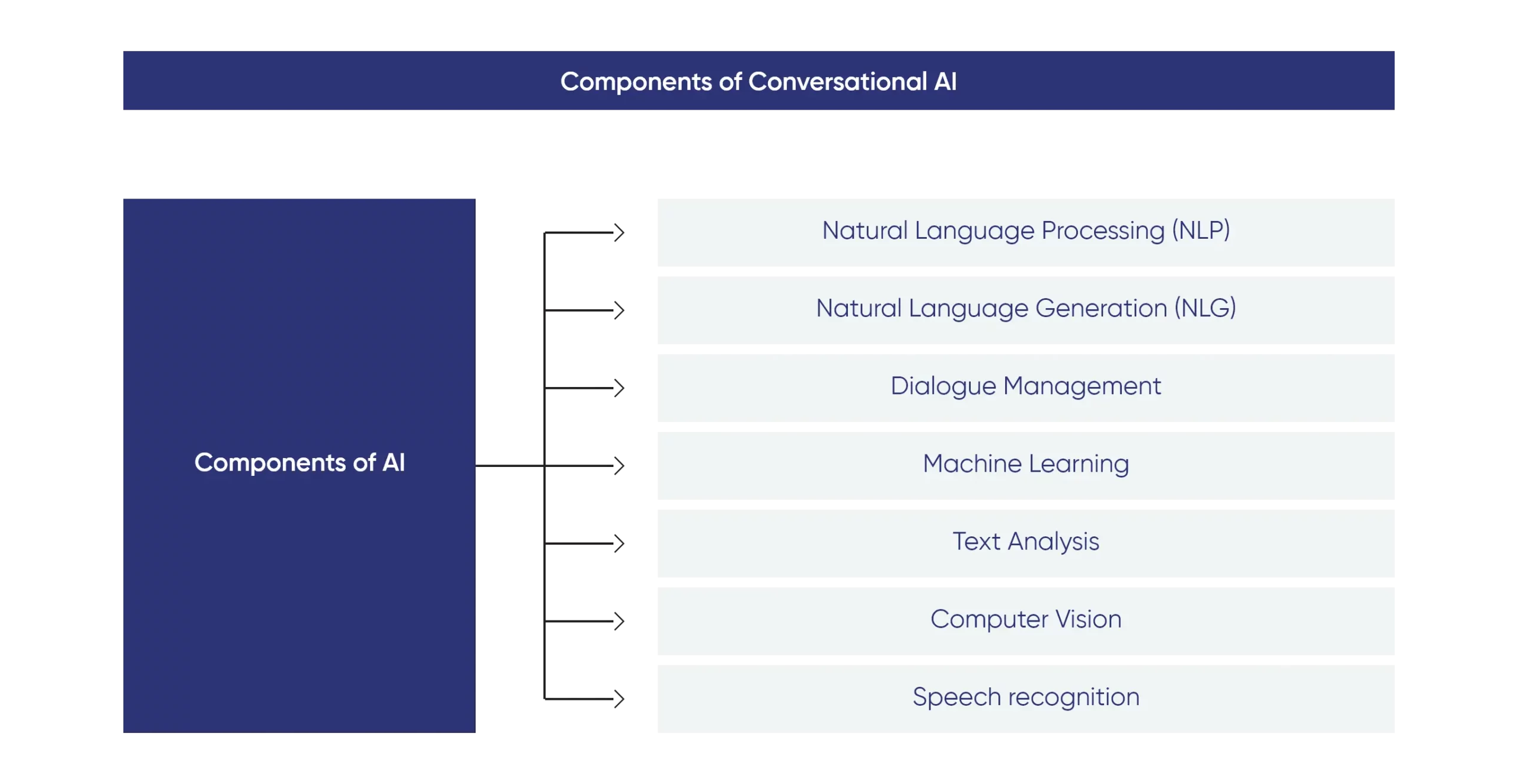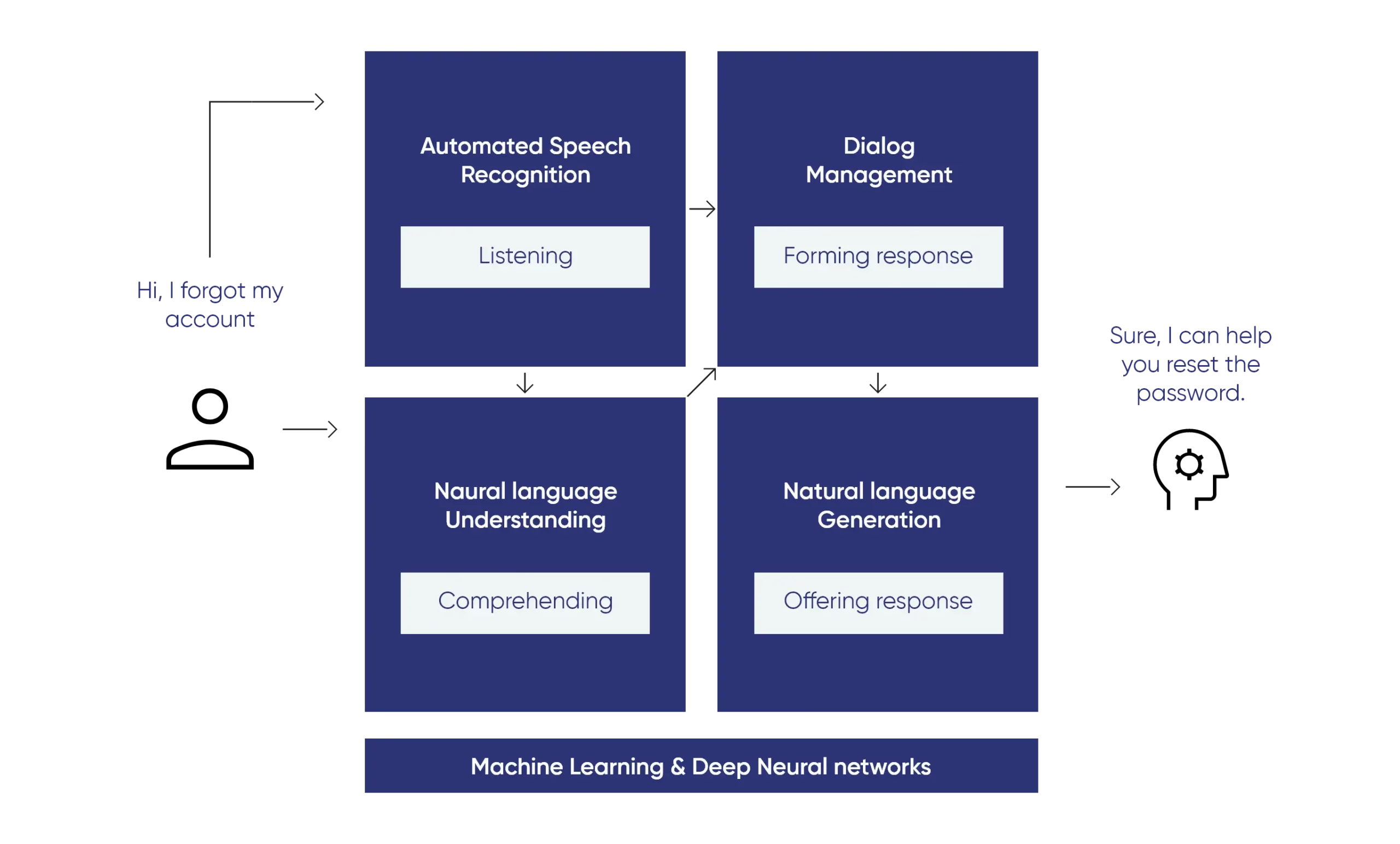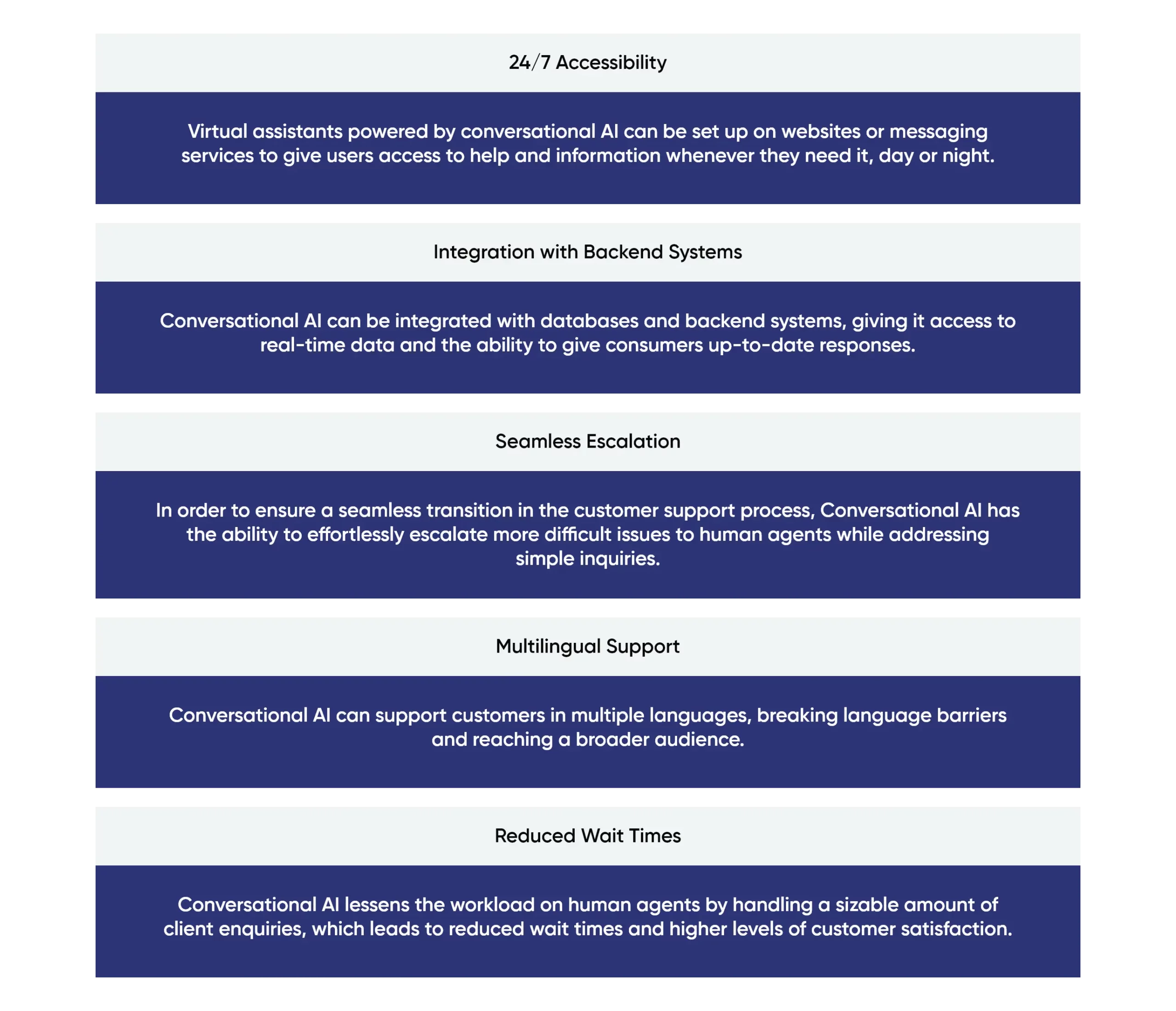What is Conversational AI?
“Conversational AI” refers to various techniques that allow computers to interact with people in conversation. They mimic human interactions by recognizing audio and text inputs and translating their contents into other languages utilizing large volumes of data, machine learning, and natural language processing.
Chatbots, which employ NLP to decipher user inputs and carry on a conversation, are one of the most common applications of conversational AI. Other applications of conversational AI include virtual assistants, chatbots for customer service, and voice assistants.
Customer service departments frequently deploy conversational AI solutions. They can be found on websites, online stores, and social media platforms. AI technology can efficiently expedite and streamline the process of answering and directing client questions. It fuels interactions close to humans, enhancing customer experience (CX), improving satisfaction, fostering loyalty, and raising customer lifetime value (LTV).
Chatbots, which employ NLP to decipher user inputs and carry on a conversation, are one of the most common applications of conversational AI. Other applications of conversational AI include virtual assistants, chatbots for customer service, and voice assistants.
Customer service departments frequently deploy conversational AI solutions. They can be found on websites, online stores, and social media platforms. AI technology can efficiently expedite and streamline the process of answering and directing client questions. It fuels interactions close to humans, enhancing customer experience (CX), improving satisfaction, fostering loyalty, and raising customer lifetime value (LTV).

Numerous elements that collectively enable human-like speech make up conversational AI. The main elements are as follows:
Natural Language Processing (NLP)
NLP is the study of how computers comprehend and use human language. This requires being able to manage colloquial expressions and slang. It comprises entity recognition, sentiment analysis, entity tokenization, syntactic and semantic analysis, and language recognition. NLP aids in understanding user inputs and locating pertinent data.
Natural Language Generation (NLG)
Based on the comprehension of user input, NLG entails producing responses that sound human. It converts structured data or system knowledge into user-understandable, cohesive, and contextually suitable language. Simple rule-based templates and more complex machine-learning models are also used in NLG techniques.
Dialogue Management
The goal of dialogue management is to control the flow of conversations between the user and the system while keeping context. The discussion history can be tracked, user intentions can be understood, system actions can be determined, and appropriate replies can be generated. For managing dialogue, rule-based methods and reinforcement learning are frequently employed.
Machine Learning
Conversational AI heavily relies on machine learning. Machine learning models are trained on big datasets to enhance language understanding, answer generation, and dialogue management capabilities. Conversational AI models are typically trained using deep learning, neural networks, and reinforcement learning. Machine learning algorithms can automatically become more effective as they encounter more data.
Text Analysis
Text analysis is the technique of extracting information from text data. This requires identifying the various components of a sentence, such as the subject, verb, and object. It is also necessary to recognize the different word categories in a phrase, such as verbs, nouns, and adjectives. Text analysis is used to decipher a sentence’s meaning and the links between its words.
Computer Vision
Computer vision refers to a computer’s ability to comprehend and interpret digital images. This entails recognizing the many items in an image and their positions and angles. Computer vision is used for identifying both the contents of an image and the associations between its various pieces. It is also utilized to comprehend a photograph’s context and decipher the emotions of the individuals in it.
Speech Recognition
By converting spoken words into written text, speech recognition enables computer systems to process and comprehend user voice inputs. It involves using algorithms that listen to audio signals, recognize words and phonemes, and then translate those words into text. For voice-based conversational AI applications, speech recognition is crucial.
These elements combine to form conversational AI systems that can comprehend human input, produce appropriate responses, maintain context, and participate in engaging and dynamic discussions.
What is Conversation Design, and why is it Necessary for Conversational AI?
Conversation design is the process of establishing meaningful dialogues between humans and conversational AI systems, such as chatbots, virtual assistants, and voice interfaces, in a natural, entertaining, and interactive way. Designing the conversation’s flow, coming up with suitable responses, and keeping the user’s experience in mind while interacting with the system are all part of this process.
Effective conversation design ensures a seamless and positive user experience. Users should feel comfortable and understood while interacting with the AI system. Well-designed conversations lead to higher user satisfaction and adoption. Since conversational AI engaged in customer service must handle requests quickly and satisfactorily, the ability to identify and manage purpose is essential for a successful resolution. Actual conversations train machine learning (ML) models to grasp intent better.
Conversational AI aims to simulate human-like interactions. Conversation design helps create more natural, empathetic, and less robotic responses, enhancing user engagement. The architecture of conversations takes into account possible mistakes and edge circumstances that could occur during interactions. This enables the AI to react appropriately when it receives an unexpected input or query it doesn’t comprehend.
The delivery of solutions for specific use cases, such as customer care, IT service desk, marketing, and sales assistance, depends on conversational AI technology. Additionally, conversational AI allows for interaction with SMS, web-based chat, and other messaging systems’ chat interfaces.
Effective conversation design ensures a seamless and positive user experience. Users should feel comfortable and understood while interacting with the AI system. Well-designed conversations lead to higher user satisfaction and adoption. Since conversational AI engaged in customer service must handle requests quickly and satisfactorily, the ability to identify and manage purpose is essential for a successful resolution. Actual conversations train machine learning (ML) models to grasp intent better.
Conversational AI aims to simulate human-like interactions. Conversation design helps create more natural, empathetic, and less robotic responses, enhancing user engagement. The architecture of conversations takes into account possible mistakes and edge circumstances that could occur during interactions. This enables the AI to react appropriately when it receives an unexpected input or query it doesn’t comprehend.
The delivery of solutions for specific use cases, such as customer care, IT service desk, marketing, and sales assistance, depends on conversational AI technology. Additionally, conversational AI allows for interaction with SMS, web-based chat, and other messaging systems’ chat interfaces.
How does Conversational AI work?
A standard conversational AI flow, which is supported by deep neural networks (DNN) and underpinning machine learning, consists of the following:
Automatic Speech Recognition (ASR) is a user interface that turns speech into text or an interface that enables the user to input text into the system.
Natural language processing (NLP) may convert unstructured text into structured data by understanding the user’s intent from text or voice input.
Natural Language Understanding (NLU) is used to extract the user’s purpose, as well as any relevant entities or parameters, from the text. Tokenization, part-of-speech tagging, named entity identification, and purpose categorization are a few of the processes involved.
Artificial Intelligence Model (ALM) predicts the user’s optimum course of action using the user’s intent and the model’s training data. All these processes are inferred by Natural Language Generation (NLG), which then creates a suitable response to communicate with people. It’s important to remember that different conversational AI models combine these strategies in different ways, and the area is constantly changing due to improvements in AI and NLP technology.
Natural language processing (NLP) may convert unstructured text into structured data by understanding the user’s intent from text or voice input.
Natural Language Understanding (NLU) is used to extract the user’s purpose, as well as any relevant entities or parameters, from the text. Tokenization, part-of-speech tagging, named entity identification, and purpose categorization are a few of the processes involved.
Artificial Intelligence Model (ALM) predicts the user’s optimum course of action using the user’s intent and the model’s training data. All these processes are inferred by Natural Language Generation (NLG), which then creates a suitable response to communicate with people. It’s important to remember that different conversational AI models combine these strategies in different ways, and the area is constantly changing due to improvements in AI and NLP technology.

Transforming Customer Service with Conversational AI
Conversational AI can transform customer service by giving customers more effective, individualized, and exciting experiences. The following are a few ways that conversational AI might improve customer service:

It is critical to strike the right balance between automation and human connection. However, some questions call for human empathy and comprehension, which AI may not be entirely capable of providing. Therefore, the most successful way to transform customer service is by using a hybrid strategy that incorporates the advantages of both conversational AI and human agents.
Stay tuned for part 2 of the blog as we delve deeper into the world of Conversational AI.










Recent Comments